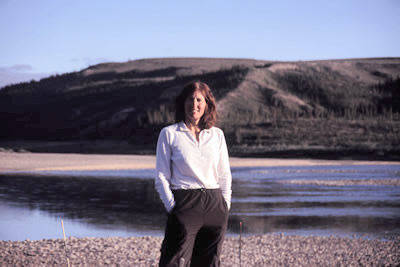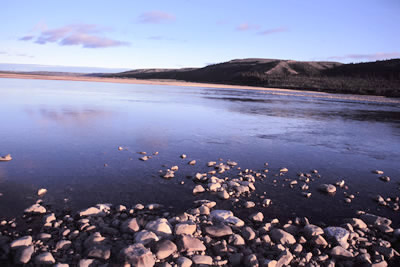Day 21 (July 26)
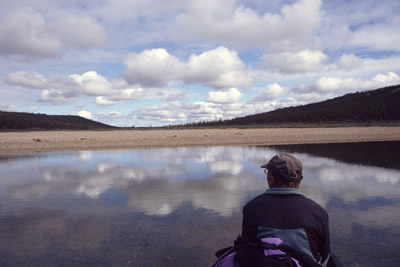 Early to bed yesterday – we were all yawning at 7: 45 pm, managed to stay up until 8:30 with great effort! Double bodum coffee morning, a treat. Slopes are once again heavily forested, seems to be good habitat for caribou providing shelter but I like the barren slopes of treeless tundra. Uneventful morning paddle with calm winds, and gentle slopes. Yawn! Feeling very very mellow…sun warms our backs, alternate drift and lily dip paddle.
Early to bed yesterday – we were all yawning at 7: 45 pm, managed to stay up until 8:30 with great effort! Double bodum coffee morning, a treat. Slopes are once again heavily forested, seems to be good habitat for caribou providing shelter but I like the barren slopes of treeless tundra. Uneventful morning paddle with calm winds, and gentle slopes. Yawn! Feeling very very mellow…sun warms our backs, alternate drift and lily dip paddle.
Things change rapidly after lunch. About km 180, a tern almost playfully harassing a gaggle of young birds which peck at the margin of willows and beach, catches our attention. We drift over for a closer look. A marsh hawk silently suddenly appears, flits its lilting flight just above the willows. With the precision of long practice, the hawk folds its wings and drops into the group of flightless chicks. Our mouths agape, we witness the kill – the eerie calls from the distressed ptarmigan are haunting, layered with the dying calls of the soon dead chick. As we beach our boats, the harrier departs, dead chick in feet – 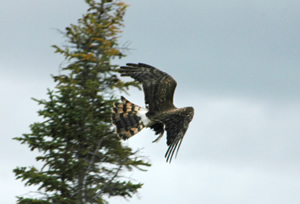 all that’s left are a pile of feathers and soft imprints in the sand.
all that’s left are a pile of feathers and soft imprints in the sand.
Next stop is to be Coal Creek, about 4 km downstream. Listening and watching, again I hear and see a flock of ptarmigans arise from shrubs in the forest. A brown gold hump emerges from the willows, showing cause for the commotion. The bear parts the bushes and steps onto the beach. He glances our way but continues to sniff the sand for siksik who have dashed into their dens. Walking along the beach, our drift is the same speed as his beach patrol. This continues for 15 minutes until he steps back into the willow cover from where he came, disappearing from view. Wow! Marvel at his thick tufted overcoat which ripples, twitches in time with his footsteps as he walks along.
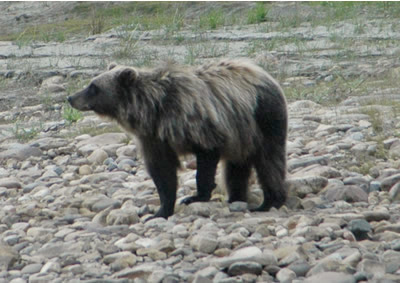
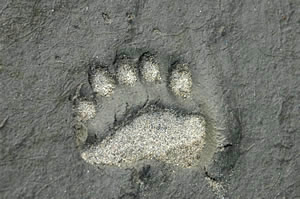
After some debate, we beach the canoes slightly down stream from Coal Creek mouth. Stefansson over wintered here with 8 to 10 others in 1914. The cabin crudely built almost 100 years ago, has now been reduced to a pile of wood. A vague trip report from 2002 group located the ruins, and we hope to do the same. We don’t know the exact location, in fact we don’t even know which side of the creek to search. But that is not the point: we beat through the dense willows to shortcut the first of the creek meanders, calculating the most likely place for the cabin would be deep in the trees for materials during construction, wind shelter and wood supply.
The trip reports says 3 miles or 3 km inland – we can’t remember which. After 2 hours, our search efforts begin to flag. We find stumps of axe cut trees, the framework of an old snare, bleached leg bones we think are bear due to thickness and great heft, a cartridge but no ruins and eventually turn back to the boats. Funny how things turn out….taking a different short cut through the willows back towards the Horton, we start to come across more cut stumps. A slight rise in the ground and voila, ruins! Nothing left but tumbled in logs, some ribs of boat framing, drying rack (?), a few rusted metal cans. Satisfied with our find, we speculate and return to the canoes
.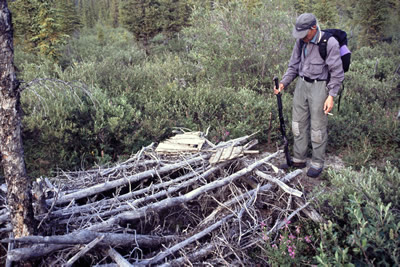
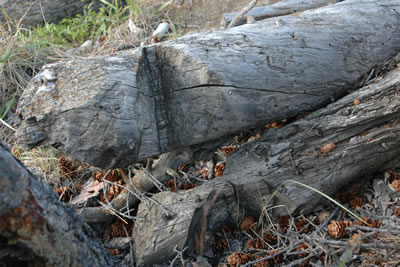
It’s getting late (7:30pm). Checking several places, a site high on a bank is deemed satisfactory. My back is killing me, I stagger up leaving Ron and Alfred to unload canoes and ferry gear up the bank while I set up the tundra tunnel. The evening is glorious with soft glow in the sky, gentle breeze wafts around. Swallows nest in the mud bank below camp: they flit and twitter, catching bugs that we have shaken and awaken from the low lying vegetation. A small set of gravel swifts compliments the setting. I’m joyously happy.
